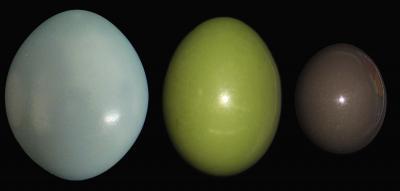Splashy blue and green hues pop from under the glassy finish of the Tinamou species' (bird relatives of ostriches, rheas and emus) eggs. Pigments covered by a thin, smooth cuticle reveal the mystery behind these curious shells, University of Akron researchers discovered. The finding could lead to the development of glossy new coatings forceramics and floors, potentially enhancing their aesthetic qualities and durability.
After removing the outer layer of the eggshells and examining their chemistry and nanostructure, the researchers discovered the presence of a weak iridescence in the Tinamou's eggshells, creating superficial colors and color changes depending on the angle at which they are viewed and the light cast upon them. The researchers' investigation of how non-pigmentary nanometer-scale structures influence light reflection and produce iridescence that impact eggshell coloration has never before been documented.
"The perceived color changes in relationship with the angles of observation and illumination. This effect can only be produced by nanostructures that influence how light is reflected," says UA post-doctoral researcher Brani Igic. He used experimental manipulations in conjunction with angle-resolved spectrophotometry, scanning electron and atomic-force microscopy, optical calculations and chemical analyses to examine the mechanical construction behind the eggshell gloss and coloration.

From left to right: eggs of the great tinamou (Tinamus major), elegant crested tinamou (Eudromia elegans), and spotted nothura (Nothura maculosa).
(Photo Credit: Photograph of great tinamou egg (UMMZ 191600) used with permission from the University of Michigan Museum of Zoology. Photo s: D. Hanley (great tinamou) and M. Hauber (elegant crested tinamou and spotted nothura).)
Igic and UA research team members Matthew Shawkey, associate professor of biology, and graduate students Daphne Fechyr-Lippens and Ming Xiao, Andrew Chan and Geoffrey I. N. Waterhouse from the University of Auckland in New Zealand, Daniel Hanley and Tomas Grim from Palacký University in the Czech Republic, Patricia R. L. Brennan from the University of Massachusetts, and Mark E. Hauber from Hunter College also found Tinamou eggs' sheen results from an ultra-smooth coating, or cuticle, distinct from typically bumpy eggshells.
"This smoothness causes light to be reflected in a specular manner, like off of a lake or mirror. The bumpiness of other eggs causes them reflect light diffusely, like a cloud," Shawkey explains.
"The research uncovers the longstanding mystery about the cause of these eggs' glossy appearance and shows that birds can make surfaces that rival those of highly polished manmade materials," Shawkey says. "How they do this during egg development and why are great questions for the future."
Source: University of Akron